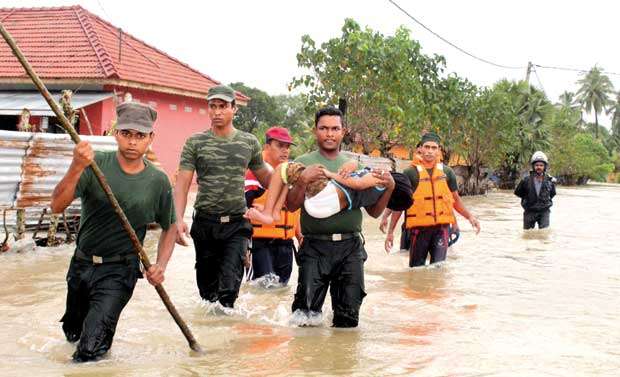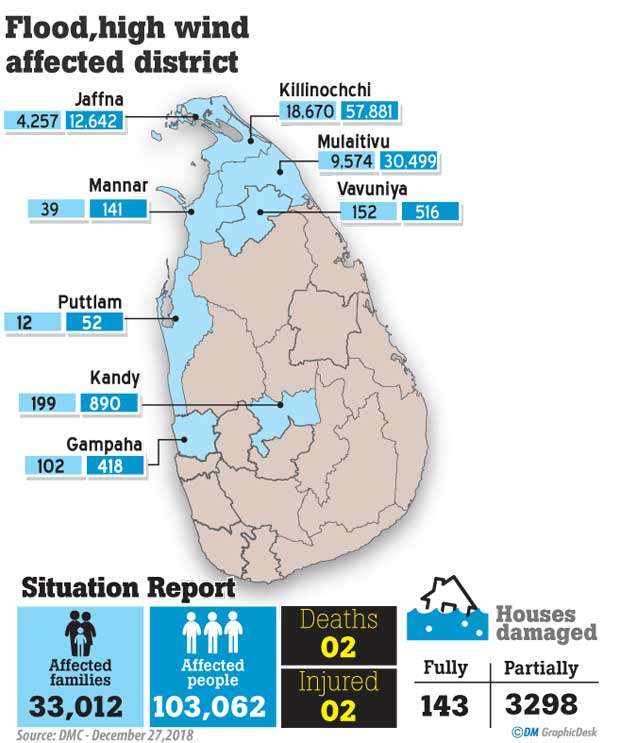28 Dec 2018 - {{hitsCtrl.values.hits}}

December is a month that people always look forward to. From Christmas to New Year’s Eve, there are plenty of reasons to rejoice. But apart from these, for most Sri Lankans, December is a dark month. 14 years ago, the Indian Ocean tsunami swept away many lives that never returned. The impact of this disaster is felt to date. 14 years after, December once again made headlines with a sudden flash flood which affected several districts in the North. Although rescue missions have been completed, the families need to be relocated and most importantly, their lives need to be restored to normalcy.
Flooding that begins within six hours, and often within three hours, of the heavy rainfall (or other cause). Flash floods can be caused by a number of things, but are most often due to extremely heavy rainfall from thunderstorms. Flash floods can occur due to dam or lever breaks, and/or mudslides (debris flow). The intensity of the rainfall, the location and distribution of the rainfall, the land use and topography, vegetation types and growth/density, soil type, and soil water-content all determine just how quickly the flash flooding may occur, and influence where it may occur.
most often due to extremely heavy rainfall from thunderstorms. Flash floods can occur due to dam or lever breaks, and/or mudslides (debris flow). The intensity of the rainfall, the location and distribution of the rainfall, the land use and topography, vegetation types and growth/density, soil type, and soil water-content all determine just how quickly the flash flooding may occur, and influence where it may occur.
The flash flood in the North has affected 27,656 families and 86,695 individuals. In addition to that 86 fully constructed houses have been destroyed while 1,308 other houses have experienced slight damages. The affected families and individuals are being temporarily housed in 25 camps. Two deaths have been reported from Maradankeni, Jaffna and Kandavalai, Kilinochchi. The highest number of affected families have been reported from Kilinochchi and Mullaitivu districts. In addition to that, 85 individuals from Nanattan, Mannar and 501 individuals from Jaffna are also affected by the floods.With a heavy rainfall exceeding 300 mm areas including Pannankandi, Rathnapuram, Anandapuram, Ramanadapuram, Murusumottai, Ponnagar, Periyakulam, Thambirasapuram and Ulavanur have been affected. Speaking to the Daily Mirror, a few area residents said that the Sri Lankan Army has been involved in cleaning wells in these areas.
“The existing flood was caused due to the accumulation of rainwater and it is not a big issue that requires foreign aid,” said Pradeep Kodippili, Deputy Director - Early Warning at the Disaster Management Centre. “The situation is slowly returning to normal and we have already relocated 4000-5000 families. Those who have experienced severe damages will receive compensation up to 25 lakhs, depending on the severity of the damage.”
“We have completed all our duties and the rescued individuals are now in camps,” said Army Media Spokesman Brigadier Sumith Atapattu. “We conducted rescue missions for three days and the responsibilities are now vested upon the civil administration.”
In his comments, Government Agent of Kilinochchi, Sundaram Arumainayakam said that six committees would be appointed to conduct assessments on the damage. “So far, 22,000 families have been affected and 1642 families are in 17 welfare centres. We provide them with cooked meals, first aid, sanitary supplies and other necessary facilities and are looking after them. The six committees will report on the damage to houses, crops, livestock and infrastructure and I have asked them to submit the reports in one week’s time. So far the situation is under control and the weather conditions seem to be favourable as well. We have already started relocating the families and some of the welfare centres will be closed from today. I have to acknowledge the support extended by the Army and the Police to conduct the rescue missions.”

30 Nov 2024 3 hours ago
30 Nov 2024 4 hours ago
30 Nov 2024 7 hours ago
30 Nov 2024 9 hours ago
30 Nov 2024 30 Nov 2024